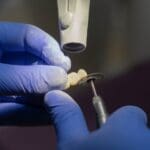If you are living with a tooth that is damaged (but not lost), you can restore its shape, function, and appearance by having that tooth crowned. Whether your tooth is damaged or is showing the signs of aging, here’s what you can expect during the process.
What Is a Crown and Why Would I Need One?
A crown, also known as a cap, is an artificial tooth that effectively covers a decaying or damaged tooth. In turn, this helps protect the tooth from any additional damage.
Just some of the reasons why your dentist may recommend a dental crown procedure:
- A weak or damaged tooth
- A discolored tooth
- A broken tooth
- A large filling
- If you have undergone a significant dental treatment, such as a root canal
Related: Aging and Dental Health
The crown itself looks incredibly natural and is made from one of several materials. These include porcelain, resin, ceramic, or less commonly, stainless steel. Since there are pros and cons to each option, you should discuss your personal needs with your dentist.
What Can I Expect When Undergoing This Procedure?
Once you and your dentist decide that a crown is right for you, the entire procedure is typically completed in two visits. During your first appointment, your tooth (or teeth) will be thoroughly examined to better understand what the best course of action is.
The main thing that your dentist will look for is whether or not your tooth can actually support the introduction of a crown. If you are an ideal candidate, your dentist will then file down the area to better prepare for crown installation. In some cases, when teeth are extremely damaged, they first need to be filled in order to make it large enough to fit a crown.
Once the tooth is the proper shape, an impression will be made of the tooth itself, as well as the teeth that surround it. These impressions are then used to create a stone model of your teeth. In some cases, your dentist will also record the exact shade of your teeth.
This will allow a professional dental lab to create a permanent crown that is custom-made for you. If your crown involves one of your front teeth, you may also need to visit the lab so that the technician can record a custom shade in relation to your surrounding teeth. Just like the initial procedure for veneers, you will leave the first appointment with a temporary crown.
There are a couple of reasons why a temporary crown is so important:
- First of all, your dentist will have removed a significant amount of tooth. This means that you will require some sort of barrier to keep your prepared tooth in shape. If you did not have this crown and your tooth shifted, your custom crown would no longer fit.
- Secondly, you will need to keep your tooth protected. Depending on your situation, you could experience extreme sensitivity to both pressure and temperature. That is because, during the initial visit, most of your enamel will be removed, exposing dentin. However, if you had a root canal, there will not be any feeling in the tooth.
Please note: You should always follow the instructions provided to you in regards to your temporary crown. If at any time your temporary crown falls off, you need to contact your dentist immediately. Urgent care may be required. You will also receive detailed post-operative instructions following the installation of your permanent crown. Please follow them as directed.
Once your permanent crown is ready, you will then come in for your second visit. On average, this, it will take a dental lab between seven and ten days to make your custom crown. When you return for your second appointment, your dentist will typically numb the area using a local anesthetic and thoroughly clean the tooth.
After removing the temporary crown, your dentist will then test out the crown. Once your crown is successfully put in place, your dentist will then check the contacts between the crown itself and the teeth that surround it. This is done to ensure that you can effectively floss.
Once satisfied with the crown’s placement, your dentist will fix it to the tooth using a special adhesive. To successfully complete this step, the area needs to remain dry. This is why dentists typically place a cotton roll on both sides of the affected tooth. After approximately ten minutes (allowing the permanent cement to set), your dentist will check how well your teeth align when you bite down.
Caring for Your Crown
At first, it may feel odd — but it will look great. However, in no time, that tooth with feel normal and function like a regular tooth. Just like regular teeth, you will need to practice an optimal oral hygiene which includes brushing and flossing multiple times daily. You should also visit your dentist regularly for routine cleanings (which will also allow your dentist to check on your crown).
As long as you take care of your teeth (and new crown), you should not experience any discomfort or pain. Best of all, when you maintain positive oral health, your crown will last anywhere from fifteen to thirty years.
Not sure if a crown is right for you? Please give one of our seven locations a call to schedule a consultation— we’d be happy to assist you and your smile!









